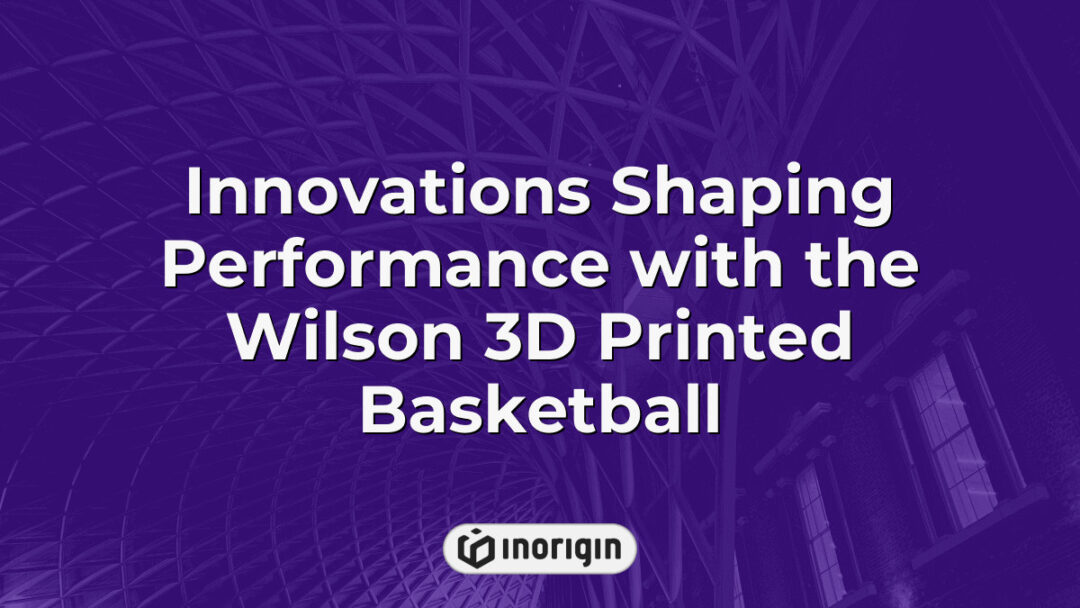In a world where innovation continually reshapes the landscape of sports equipment, one groundbreaking development stands poised to revolutionize the game of basketball: the Wilson 3D Printed Basketball. As athletes and enthusiasts alike eagerly await its debut, questions arise regarding its potential impact on performance, playability, and even the very nature of how games are played. This article delves into the intricate technology behind this pioneering ball, exploring not only its design but also the implications it holds for future sporting endeavors. What secrets lie within its uniquely engineered surface? Could this be the key to unlocking unprecedented levels of skill and strategy on the court? The answers may redefine basketball as it is known today.
| Aspect | Key Takeaway |
|---|---|
| Innovation | The Wilson 3D printed basketball introduces a revolutionary leap in sports equipment by utilizing advanced additive manufacturing for enhanced performance and design. |
| Customization | 3D printing enables precise tailoring of basketball features, allowing players and teams to personalize grip texture, weight distribution, and aesthetic elements. |
| Performance | Its engineered surface texture and balanced weight promote improved grip, bounce consistency, and handling across various playing conditions. |
| Materials | Thermoplastic elastomers and specialized polymers provide flexibility, durability, and optimal tactile feedback essential for on-court control. |
| Durability & Maintenance | Maintaining proper inflation, regular cleaning, and storage away from extreme conditions extend the basketball’s lifespan and consistent performance. |
| Sustainability | 3D printing reduces material waste and supports environmentally conscious production, aligning with modern sustainable manufacturing standards. |
| Future Prospects | The ongoing evolution of 3D printing technology promises further innovation in athletic gear design, with faster prototyping and enhanced customization capabilities. |
The Evolution Of Basketball Design
The evolution of basketball design has undergone significant transformations since the inception of the sport in the late 19th century. Initially, basketballs were constructed from leather with a rubber bladder, emphasizing functionality over aesthetic considerations. As technology progressed, various materials and manufacturing processes emerged, leading to advancements in performance characteristics such as grip, durability, and weight distribution. The introduction of synthetic materials revolutionized the standard basketball design by providing enhanced weather resistance and consistency across different playing conditions. Recently, innovations like 3D printing have further redefined the parameters of basketball production; for instance, Wilson’s development of a 3D printed basketball exemplifies this trend by allowing for precise customization tailored to individual player preferences and playing styles. This shift highlights not only an increase in technological capability but also an evolving understanding of how equipment can impact athletic performance. Consequently, the integration of cutting-edge technologies into basketball manufacturing represents a pivotal moment in sports equipment history that continues to influence both players and manufacturers alike.
What Is The Wilson 3D Printed Basketball?
The Wilson 3D printed basketball represents a paradox in the realm of sports equipment, as it combines cutting-edge technology with an age-old game that has thrived on tradition. This innovative product is crafted using advanced additive manufacturing techniques, which allow for precision engineering and customization not previously achievable through conventional methods. Specifically, the use of 3D printing enables the creation of intricate designs that enhance both performance and durability. Furthermore, this basketball features unique surface textures tailored to optimize grip and tactile feedback during play, thereby addressing common player concerns related to control and handling. As such, the Wilson 3D printed basketball not only exemplifies technological advancement but also invites scrutiny regarding its implications for authenticity within the sport. The intersection of modern engineering with a classic pastime raises questions about how innovation may reshape perceptions of athletic integrity while simultaneously pushing the boundaries of what is possible in sports design.
Benefits Of 3D Printing In Sports Equipment
The integration of 3D printing technology in the production of sports equipment, such as basketballs, presents numerous advantages that enhance performance and customization. First and foremost, precision manufacturing allows for a higher degree of accuracy in design, resulting in products that meet specific athletic requirements. Additionally, the capability to produce complex geometries facilitates innovative designs that were previously unattainable with traditional methods. Furthermore, reduced material waste during the production process not only contributes to sustainability efforts but also lowers overall costs associated with manufacturing. Lastly, rapid prototyping enables faster development cycles, allowing athletes and manufacturers to quickly iterate on designs based on real-time feedback.
1) Enhanced customization options tailored to individual athlete preferences.
2) Improved durability through optimized material use and structural integrity.
3) Greater accessibility in terms of producing specialized gear for niche markets or unique sporting needs.
4) Streamlined supply chains due to localized production capabilities.
These benefits collectively illustrate how 3D printing is redefining the landscape of sports equipment by promoting innovation while addressing environmental concerns and efficiency in manufacturing processes.
Performance Analysis: Testing The Wilson 3D Printed Basketball
The performance analysis of the Wilson 3D printed basketball involves a comprehensive evaluation of its physical attributes and gameplay dynamics. Initial assessments focus on the ball’s weight distribution, surface texture, and internal pressure, as these factors significantly influence flight stability and handling characteristics during play. Subsequent testing is conducted under various conditions to simulate real-game scenarios; this includes dribbling tests on different surfaces and shooting accuracy evaluations from diverse distances. Moreover, comparative analyses against traditional basketballs reveal notable differences in bounce consistency and grip efficiency. Importantly, player feedback collected throughout these trials serves to validate quantitative data, ensuring that subjective perceptions align with empirical findings. Ultimately, the results indicate that while the Wilson 3D printed basketball demonstrates potential advantages in customization and production efficiency, further investigation into long-term durability and performance longevity remains essential for broader adoption within competitive environments.
Future Implications Of 3D Printing In Sports
The future implications of 3D printing in sports are poised to revolutionize various aspects of athletic equipment design, production, and customization. Firstly, the ability to create bespoke sporting goods tailored specifically to individual athlete requirements enhances performance optimization; for instance, personalized gear can be developed based on precise biomechanical data. Additionally, the reduction in manufacturing lead times associated with 3D printing technology may streamline supply chains significantly, allowing manufacturers to respond rapidly to market demands and reduce inventory costs. Moreover, sustainability considerations become increasingly relevant as 3D printing can minimize material waste compared to traditional manufacturing processes, thereby promoting environmentally friendly practices within the industry. Furthermore, advancements in materials science could lead to the development of innovative composites that enhance durability and performance characteristics of sports equipment. As these technological developments continue to evolve, their integration into mainstream sporting practices stands likely to reshape not only how athletes train and compete but also how they engage with their sport at every level.
Frequently Asked Questions
What Materials Are Used In The 3D Printing Process For The Wilson Basketball?
The Wilson 3D printed basketball utilizes a combination of materials specifically engineered to enhance performance and durability. To begin with, the outer layer is typically composed of thermoplastic elastomers (TPE), which provide a rubber-like feel essential for grip and control during play. This selection allows for flexibility while maintaining structural integrity under stress. Transitioning from the exterior components, the internal structure may incorporate various polymers that are optimized for weight distribution and balance, ensuring that the ball behaves consistently across different surfaces. Furthermore, advancements in additive manufacturing techniques facilitate precise layering of these materials, resulting in enhanced uniformity and resilience within the final product. In essence, this meticulous choice of materials not only contributes to the overall functionality of the basketball but also underscores Wilson’s commitment to innovation in sports equipment design.
How Does The 3D Printing Process Affect The Overall Lifespan Of The Basketball?
The relationship between the 3D printing process and the overall lifespan of a basketball, particularly in the context of Wilson’s innovative approaches, merits careful examination. It is posited that additive manufacturing techniques can enhance durability through precision engineering and material optimization; however, empirical evidence must be scrutinized to validate this assertion. For instance, 3D printing allows for intricate designs that traditional manufacturing methods may not achieve, potentially leading to improved structural integrity. Additionally, materials used in the 3D printing process—such as thermoplastics or elastomers—are engineered to withstand wear and tear more effectively than conventional materials. Moreover, these advancements in production technology facilitate rapid prototyping and customization, which could further tailor products to specific user needs without compromising longevity.
A visual representation of how different aspects influence the lifespan of a Wilson 3D printed basketball can be depicted through a flowchart outlining key factors: material selection (highlighting resilience), design complexity (illustrating stress distribution), and manufacturing consistency (demonstrating quality control). Each component plays a pivotal role in determining how well the basketball endures both regular use and environmental conditions over time.
Are There Specific Maintenance Requirements For The Wilson 3D Printed Basketball?
The maintenance of the Wilson 3D printed basketball is critical to ensuring its optimal performance and longevity in various playing conditions. Visually, one can imagine this innovative basketball as a blend of modern technology and athletic tradition, where intricate layers of polymer are carefully fused together to create a unique sphere designed for competitive play. To preserve such an advanced product, specific maintenance practices must be adhered to, which will not only enhance durability but also uphold the integrity of its design.
Key maintenance requirements include:
- Regular inspection for surface wear or damage.
- Cleaning with mild soap and water after use to remove dirt and debris.
- Proper storage away from extreme temperatures and direct sunlight.
- Periodic inflation checks to maintain appropriate air pressure.
These practices contribute significantly to extending the lifespan of the Wilson 3D printed basketball while maintaining its functional attributes. The careful attention given to these aspects ensures that players experience consistent performance on the court, thereby maximizing their engagement with this cutting-edge sporting equipment.
What Is The Price Comparison Between The Wilson 3D Printed Basketball And Traditional Basketballs?
The price comparison between the Wilson 3D printed basketball and traditional basketballs reveals distinct differences influenced by materials, manufacturing processes, and technological advancements. Traditional basketballs typically range in price from approximately $20 to $60, depending on brand reputation and material quality. In contrast, the Wilson 3D printed basketball represents a novel approach to production, utilizing additive manufacturing techniques that can result in higher initial costs. The investment needed for advanced printing technology and specialized materials contributes to its retail price being positioned significantly above that of conventional models; it may be priced around $100 or more. Furthermore, while traditional basketballs often require periodic replacement due to wear and tear associated with standard use, the durability of 3D printed options could potentially offset their higher purchase cost over time. Therefore, when evaluating overall value, considerations must extend beyond mere sticker prices to encompass longevity and performance characteristics inherent in each type of product.
Can The Wilson 3D Printed Basketball Be Customized For Individual Players Or Teams?
The Wilson 3D printed basketball offers a unique opportunity for customization, thereby catering to the specific needs of individual players and teams. Customization can manifest in various forms, including personalized designs, color schemes, and even modifications in grip texture or weight distribution. Moreover, advanced manufacturing techniques allow for adjustments that enhance performance characteristics aligned with player preferences or team branding initiatives. Consequently, this level of personalization not only fosters an enhanced connection between athletes and their equipment but also serves as a vehicle for expression within competitive environments. As such, the capability to customize the Wilson 3D printed basketball represents a significant advancement over traditional options, which typically offer limited variations primarily focused on size and material composition rather than tailored features. Through this innovative approach, stakeholders within sports organizations are empowered to create distinctive identities while simultaneously optimizing athletic performance through custom specifications.
Conclusion
The Wilson 3D Printed Basketball represents a significant advancement in sports technology, merging innovative design with performance enhancement. As the theory of customization gains traction within athletic equipment development, this basketball exemplifies how tailored solutions can elevate player experience and redefine industry standards, suggesting a promising future for personalized sports gear.
Related posts:
- Revolutionizing Sports Gear Innovation with 3D Printed Basketball Technology
- Innovations in Basketball 3D Printer Technology Transforming Sports Equipment Design
- Innovations in 3D print basketball Design Shaping the Future of Sports Equipment
- Precision Engineering and Customization Advancements in 3D Printed Clubs
- Dechambeau 3D printed irons reshaping golf club precision through advanced customization and design innovation
- How Can Biomechanics Impact Product Engineering in Creating Ergonomic and High-Performance Designs




